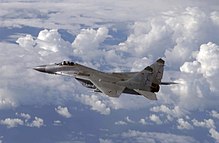
Ace Combat 04: Shattered Skies is a 2001 combat flight simulation video game developed and published by Namco for the PlayStation 2. It is the fourth entry in the Ace Combat series and the first in the series to be released for the PlayStation 2. The game's plot, set in a fictional alternate universe where Earth has been ravaged by asteroid impacts, follows the player character "Mobius 1", a fighter pilot in a multinational military coalition who spearheads the liberation of the fictional continent of Usea from the expansionist country of Erusea.
Ace Combat is an arcade-style combat flight simulation video game series by Project Aces, an internal development team of Bandai Namco Entertainment, formerly Namco. Debuting in 1995 with Air Combat for the PlayStation, the series includes eight mainline installments, multiple spin-offs, and other forms of media, such as novels, model kits, and soundtrack albums. Since 2012, the series has been developed primarily by Bandai Namco Studios through its internal development group, Project Aces.

Ace Combat 5: The Unsung War is a combat flight simulation video game developed and published by Namco for the PlayStation 2. It is the fifth installment of the Ace Combat series. A limited number of the games were bundled with the Hori Flightstick 2 accessory.
Combat flight simulators are vehicle simulation games, amateur flight simulation computer programs used to simulate military aircraft and their operations. These are distinct from dedicated flight simulators used for professional pilot and military flight training which consist of realistic physical recreations of the actual aircraft cockpit, often with a full-motion platform.

Air Combat is a 1995 combat flight simulation video game developed and published by Namco for the PlayStation, and the first title of the Ace Combat franchise. Players control an aircraft and are tasked with completing a series of missions, with objectives ranging from destroying formations of enemies to protecting a specific target from enemy fire. Missions award money that is used to purchase new fighter aircraft, each with its own unique weapons and strengths.

Ace Combat Zero: The Belkan War is a 2006 combat flight simulation video game developed and published by Namco for the PlayStation 2. Part of the Ace Combat series, the game was first released outside of Japan by the newly formed Namco Bandai Games. Set in the Ace Combat series' fictional universe of Strangereal, the game's story takes place before the events of most other entries in the series, and follows the actions of "Galm Team", a mercenary fighter squadron led by the player character "Cipher", as they fight to repel an enemy invasion during the titular Belkan War, a World War II-esque conflict that was mentioned but not elaborated upon in previous entries.

Ace Combat 3: Electrosphere is a combat flight simulation video game developed and published by Namco for the PlayStation. The third game in the Ace Combat franchise, it was released in Japan on May 27, 1999 and internationally the following year. Players fly fighter aircraft and must complete a variety of mission objectives, such as destroying squadrons of enemy planes or protecting a base from an invading unit.
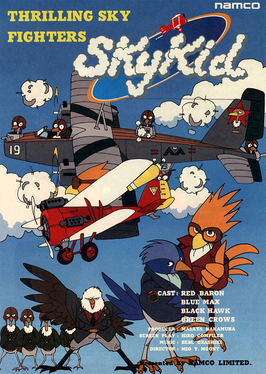
Sky Kid is a horizontally scrolling shooter arcade video game released by Namco in 1985. It runs on Namco Pac-Land hardware but with a video system like that used in Dragon Buster. It is also the first game from Namco to allow two players to play simultaneously. The game was later released on the Famicom, and both this version for the Wii, Nintendo 3DS, and Wii U and the original arcade version for the Wii were later released on Nintendo's Virtual Console service, and for the Nintendo Switch and PlayStation 4 as part of Hamster's Arcade Archives line of digital releases. The NES version was also ported to arcades for the Nintendo VS. System as VS. Super Sky Kid, but promotional materials and the cabinet for this version just use the name VS. Sky Kid.

Namco Classic Collection Vol. 1 is a 1995 arcade game compilation developed and published by Namco. It includes three of the company's most well-known games from the early 1980s — Galaga (1981), Xevious (1983), and Mappy (1983) — alongside brand-new "Arrangement" remakes of these games that have updated gameplay, visuals, and sounds. The arcade originals are also modified slightly to end after a certain number of rounds. Super Xevious (1984) is also playable. It ran on the Namco ND-1 arcade system, being one of the first games to utilize it.

Xevious 3D/G is a 1996 vertically scrolling shooter video game developed and published by Namco for arcades. The eighth entry in the Xevious series, it combines 2D-based gameplay with 3D gouraud-shaded polygon graphics. Players control the Solvalou starship in its mission to destroy a rogue supercomputer named GAMP and the Xevian Forces, using two basic weapon types: an air zapper to destroy air targets, and a blaster bomb to destroy ground targets. The game also features destructive power-ups, new bosses, and two player simultaneous play.

Sky Mission is a 1992 combat flight simulation video game developed by Malibu Interactive and published by Namco for the Super Nintendo Entertainment System. In North America, the game was rebranded as the sequel to the Commodore Amiga game Wings, titled Wings 2: Aces High, while in Europe it was renamed to Blazing Skies. As the leader of a British plane squadron during World War I, the player is tasked with destroying enemy planes under the command of German emperor Kaiser Wilhelm II in France. Gameplay involves gunning down enemies and performing bombing runs on enemy bases. The game was produced by Ken Lobb, best known as the co-creator of the Killer Instinct fighting game series, with music composed by musician George Sanger. Sky Mission was met with a mixed reaction from critics — although it was disliked for its short length and lacking gameplay, it was praised for its realistic visuals, soundtrack and sense of thrill.
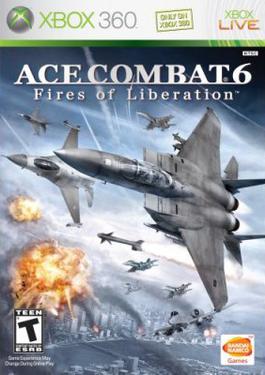
Ace Combat 6: Fires of Liberation is a 2007 arcade-style combat flight simulation video game developed by Project Aces and published by Namco Bandai Games exclusively for the Xbox 360. It is the seventh entry in the Ace Combat franchise, the first mainline game in the franchise to not see a release on a PlayStation platform as had been done with previous titles, and the first game in the franchise to include downloadable content. Like other Ace Combat games, Ace Combat 6 features standard gameplay from the series that mixes arcade flight with authentic flight simulation.
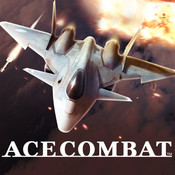
Ace Combat Xi: Skies of Incursion was a 2009 combat flight simulation video game developed and published by Namco Bandai Games for iOS.
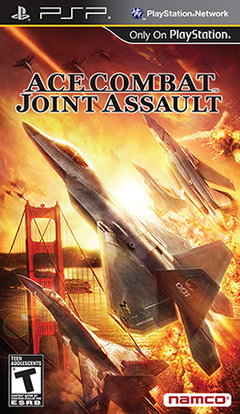
Ace Combat: Joint Assault is a 2010 combat flight simulation video game developed by Project Aces and Access Games and published by Namco Bandai Games for the PlayStation Portable. It is the second in the Ace Combat franchise to be released for the PlayStation Portable and the fourth for a portable platform. It is also the first game in the franchise to be set in the real world.

Ace Combat: Assault Horizon is a spin-off installment of the Ace Combat flight simulation video game series. It was developed by Project Aces and published by Bandai Namco Games for the PlayStation 3 and Xbox 360 platforms in October 2011. The game was later released on Microsoft Windows in January 2013 through Steam and Games for Windows – Live, with the latter notably being the final retail release for the platform shortly before its discontinuation. The title has also been removed from Steam listings.

Ace Combat: Assault Horizon Legacy, released as Ace Combat 3D: Cross Rumble in Japan, is a 2011 combat flight simulation video game developed by Access Games and published by Namco Bandai Games for the Nintendo 3DS. Despite the game's international title outside Japan, it has little relation to Ace Combat: Assault Horizon, and is instead a remake of the PlayStation game Ace Combat 2. The original Japanese version features compatibility with the Circle Pad Pro accessory.

Ace Combat Infinity was a combat flight simulation video game developed by Project Aces and published by Bandai Namco Games for the PlayStation 3. It is the sixteenth title in the Ace Combat series, and was released worldwide in May 2014. It is the first partially free-to-play title in the series, and unlike most games in the series, Infinity takes place on Earth. However, it includes certain elements from past Ace Combat games, including historical events, organizations, superweapons, and original aircraft.
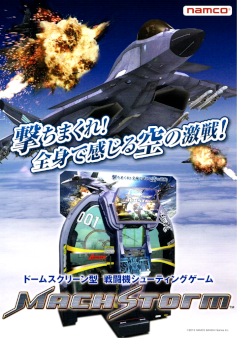
Mach Storm is a 2013 combat flight simulation arcade game developed and published by Namco Bandai Games. The player controls a fighter craft, the leader of the Storm Squadron, in a mission to prevent a terrorist group from attacking major cities worldwide. Its gameplay involves destroying fleets of enemy fighters with a lock-on targeting system and avoiding collisions with their projectiles and level obstacles. Five levels are present, each taking place in famous cities such as Miami, Tokyo, and Washington, D.C.
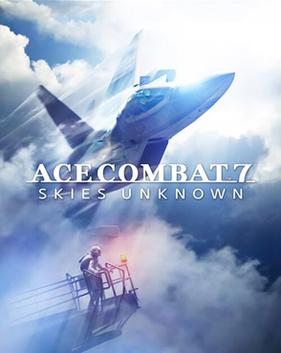
Ace Combat 7: Skies Unknown is a 2019 combat flight simulation game by Bandai Namco Entertainment. The first new entry in the Ace Combat series since 2014's Ace Combat Infinity, the game was released for PlayStation 4 and Xbox One in January 2019, and for Windows in February 2019. A Nintendo Switch port was released in July 2024.

Air Combat is a 1993 combat flight simulator arcade video game developed by Namco. The arcade game was released in 1993 for the polygon-powered Namco System 21 arcade hardware, and received praise for its 3D graphics and technological capabilities. The game was a commercial success at Japanese and American arcades in the 1990s, and inspired several later Namco games, including the arcade sequel Air Combat 22, the PlayStation game Air Combat, and the Ace Combat series.


